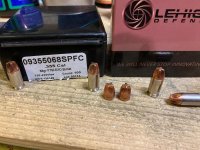Momentum is easy to understand.
weight x velocity = momentum
But is it correct?
Energy is not intuitive. Why do they give so much more credit to velocity than bullet weight when computing this?
It was worked out over 100 years ago.
E=mc²
I struggled with that for a long time.
It helps to study the terminal ballistics of a high-speed rifle bullet weighing, for example, 1/2 the weight of a handgun bullet but going twice as fast. Momentum would suggest equal results yet the light, fast rifle bullets do much more damage and have much more energy.
These fast, light fluted copper projectiles are as barrier blind and almost as deep penetrating as ball or SWC yet manage to cause a temporary wound cavity akin to a hollow point that actually expands.
Light weight lead bullets, especially hollow points don't generally have much penetration.
I think it is a good idea to keep an open mind on these projectiles. Too bad they are so expensive, being copper and all.

